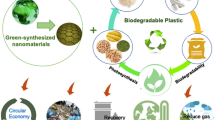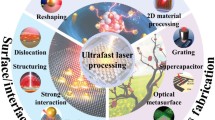Abstract
Amine-based plasma polymer thin films (NH2-PPTFs) are favorable due to their potential ability for binding a variety of biomolecules, especially in biotechnologic studies. In this context, to understand the effect of different amine sources on quartz tuning forks’ (QTF) surface functionalization and isolation, we prepared PPTFs by single-step plasma polymerization process. The amino-group concentration of PPTF’s was proportionally increased by increasing discharge powers, whereas not affected from exposure time. It was observed that the resistivity increased with the increasing molecular weight of the precursor. In conclusion, NH2-PPTF-modified QTFs present as a great candidate for future biotechnologic applications.







Similar content being viewed by others
Change history
20 September 2019
An Erratum to this paper has been published: https://doi.org/10.1557/mrc.2018.243
References
S.H. Cho, Z.T. Park, J.G. Kim, and J.H. Boo: Physical and optical properties of plasma polymerized thin films deposited by PECVD method. Surf. Coat. Technol. 174-175, 1111 (2003).
B. Alp, S. Mutlu, and M. Mutlu: Glow-discharge-treated cellulose acetate (CA) membrane for a high linearity single-layer glucose electrode in the food industry. Food Res. Int. 33, 107 (2000).
M. Mutlu, S. Mutlu, M.F. Rosenberg, J. Kane, M.N. Jones, and P. Vadgama: Matrix surface modification by plasma polymerization for enzyme immobilization. J. Mater. Chem. 1, 447 (1991).
O. Kylián, A. Choukourov, and H. Biederman: Nanostructured plasma polymers. Thin Solid Films 548, 1 (2013).
A. Choukourov, H. Biederman, D. Slavinska, M. Trchova, and A. Hollander: The influence of pulse parameters on film composition during pulsed plasma polymerization of diaminocyclohexane. Surf. Coat. Technol. 174-175, 863 (2003).
F. Shi: Recent advances in polymer thin films prepared by plasma polymerization synthesis, structural characterization, properties and applications. Surf. Coat. Technol. 82, 115 (1996).
S. Mutlu, D. Çökeliler, A. Shard, H. Goktas, B. Ozansoy, and M. Mutlu: Preparation and characterization of ethylenediamine and cysteamine plasma polymerized films on piezoelectric quartz crystal surfaces for a biosensor. Thin Solid Films 516, 1249 (2008).
E. Akdogan, D. Çökeliler, L. Marcinauskas, P. Valatkevicius, V. Valincius, and M. Mutlu: A new method for immunosensor preparation: atmospheric plasma torch. Surf. Coat. Technol. 201, 2540 (2006).
D. Losic, M.A. Cole, B. Dollmann, K. Vasilev, and H.J. Griesser: Surface modification of nanoporous alumina membranes by plasma polymerization. Nanotechnology 19, 245704 (2008).
A. Manakhov, P. Skládal, D. Necas, J. Cechal, J. Polcák, M. Eliáš, and L. Zajícková: Cyclopropylamine plasma polymers deposited onto quartz crystal microbalance for biosensing application. Phys. Status Solidi Appl. Mater. Sci. 211, 2801 (2014).
Y. Martin, D. Boutin, and P. Vermette: Study of the effect of process parameters for n-heptylamine plasma polymerization on final layer properties. Thin Solid Films 515, 6844 (2007).
A.M. Sandstrom, M. Jasieniak, H.J. Griesser, L. Grøndahl, and J.J. Cooper-White: Effects of varying heptylamine and propionaldehyde plasma polymerization parameters on mesenchymal stem cell attachment. Plasma Process. Polym. 10, 19 (2013).
J. Zhao, W. Michalski, C. Williams, L. Li, H.-S. Xu, P.R. Lamb, S. Jones, Y.M. Zhou, and X.J. Dai: Controlling cell growth on titanium by surface functionalization of heptylamine using a novel combined plasma polymerization mode. J. Biomed. Mater. Res. A 97A, 127 (2011).
A. Michelmore, D.A. Steele, J.D. Whittle, J.W. Bradley, and R.D. Short: Nanoscale deposition of chemically functionalised films via plasma polymerisation. RSC Adv. 3, 13540 (2013).
L. Betancor, F. López-Gallego, A. Hidalgo, N. Alonso-Morales, G. Dellamora-Ortiz, C. Mateo, R. Fernández-Lafuente, and J.M. Guisán: Different mechanisms of protein immobilization on glutaraldehyde activated supports: effect of support activation and immobilization conditions. Enzyme Microb. Technol. 39, 877 (2006).
X. Su, C. Dai, J. Zhang, and S.J. O’Shea: Quartz tuning fork biosensor. Biosens. Bioelectron. 17, 111 (2002).
J. Zhang and S. O’Shea: Tuning forks as micromechanical mass sensitive sensors for bio- or liquid detection. Sens. Actuators B Chem. 94, 65 (2003).
K. Fricke, P.-L. Girard-Lauriault, K.-D. Weltmann, and M.R. Wertheimer: Plasma polymers deposited in atmospheric pressure dielectric barrier discharges: influence of process parameters on film properties. Thin Solid Films 603, 119 (2016).
M. Buddhadasa, C.R. Vandenabeele, R. Snyders, and P.L. Girard-Lauriault: Single source precursor vs. precursor mixture for N-rich plasma polymer deposition: plasma diagnostics and thin film analyses. Plasma Process. Polym. 14, 17 (2017).
S. Song, K. Woon, M. Duck, E. Ju, H. Jeong, M. Kim, H. Jang, G. Seo, and D. Lyun: Applied catalysis a: general preparation of amine-immobilized solid base catalysts by plasma polymerization of 1, 2-diaminocyclohexane. Appl. Catal. A Gen. 429-430, 85 (2012).
S.W. Myung and H.S. Choi: Chemical structure and surface morphology of plasma polymerized-allylamine film. Korean J. Chem. Eng. 23, 505 (2006).
J.A. Bittencourt: Fundamentals of Plasma Physics Third Edition (Springer New York, New York, NY, 2004).
Z. Ma, H. Ming, H. Huang, Y. Liu, and Z. Kang: One-step ultrasonic synthesis of fluorescent N-doped carbon dots from glucose and their visible-light sensitive photocatalytic ability. New J. Chem. 36, 861 (2012).
J. Niu, H. Gao, L. Wang, S. Xin, G. Zhang, Q. Wang, L. Guo, W. Liu, X. Gao, and Y. Wang: Facile synthesis and optical properties of nitrogen-doped carbon dots. New J. Chem. 38, 1522 (2014).
Y.-Q. Zhang, D.-K. Ma, Y. Zhuang, X. Zhang, W. Chen, L.-L. Hong, Q.-X. Yan, K. Yu, and S.-M. Huang: One-pot synthesis of N-doped carbon dots with tunable luminescence properties. J. Mater. Chem. 22, 16714 (2012).
D.J. Wilson, N.P. Rhodes, and R.L. Williams: Surface modification of a segmented polyetherurethane using a low-powered gas plasma and its influence on the activation of the coagulation system. Biomaterials 24, 5069 (2003).
H.J. Kim, Y. Roh, S.K. Kim, and B. Hong: Fabrication and characterization of DNA-templated conductive gold nanoparticle chains. J. Appl. Phys. 105, 74302 (2009).
D.E. Weibel, C. Vilani, A.C. Habert, and C.A. Achete: Surface modification of polyurethane membranes using RF-plasma treatment with polymerizable and non-polymerizable gases. Surf. Coat. Technol. 201(7 SPEC. ISS.), 4190 (2006).
H.J. Kim, I.S. Bae, S.J. Cho, J.H. Boo, B.C. Lee, J. Heo, I. Chung, and B. Hong: Synthesis and characteristics of NH2-functionalized polymer films to align and immobilize DNA molecules. Nanoscale Res. Lett. 7, 1 (2012).
L. Zajícková, A. Manakhov, P. Skládal, M. Eliáš, D. Necas, and J. Cechal: Plasma polymerization of amine-rich films aimed at their bioapplications. Summer 2014 SVC Bulletin, 26–30 (2014).
N. Graf, A. Lippitz, T. Gross, F. Pippig, A. Holländer, and W.E.S. Unger: Determination of accessible amino groups on surfaces by chemical derivatization with 3,5-bis(trifluoromethyl)phenyl isothiocyanate and XPS/NEXAFS analysis. Anal. Bioanal. Chem. 396, 725 (2009).
Acknowledgment
The authors thank Assoc. Prof. Dr. Fatih Büyükserin and Merve Çelik for help with AFM studies.
Author information
Authors and Affiliations
Corresponding author
Rights and permissions
About this article
Cite this article
Can, G.K., Özgüzar, H.F., Kabay, G. et al. Simultaneous insulation and modification of quartz tuning fork surface by single-step plasma polymerization technique with amine-rich precursors. MRS Communications 8, 541–549 (2018). https://doi.org/10.1557/mrc.2018.79
Received:
Accepted:
Published:
Issue Date:
DOI: https://doi.org/10.1557/mrc.2018.79




